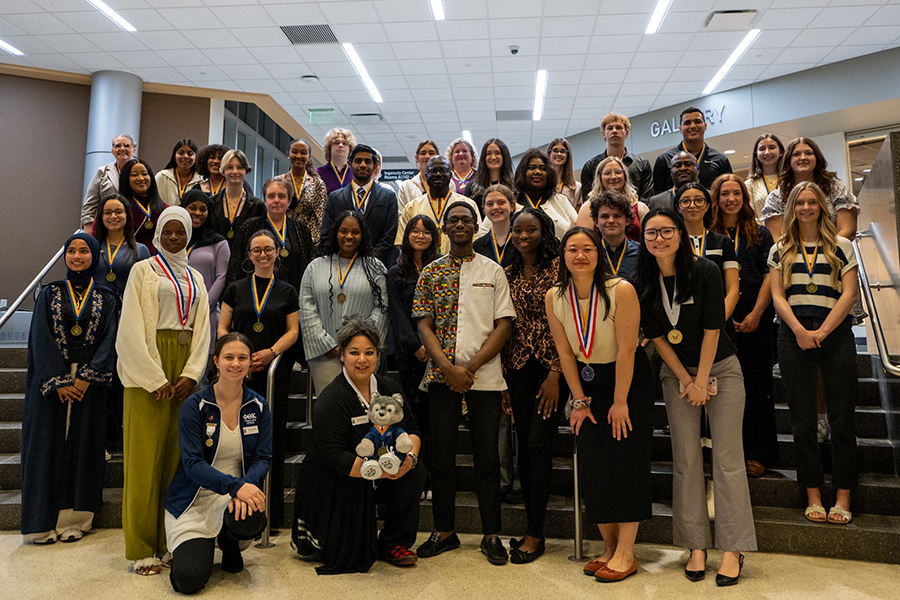Defy diabetes, the No. 7 killer of Americans
December 9, 2014
Heart disease and cancer come to mind when American mortality is discussed, but there’s another killer claiming more lives each year than AIDS and breast cancer combined. Diabetes diagnoses have risen exponentially in recent decades, and the disease is, in some cases, a preventable one. Information is power, and education as preventative medicine could save millions of lives each year.
What is it?
Diabetes is a disorder of the metabolism, which is the way our bodies digest food, and the process of turning food into energy for growth. Almost 30 million people in America have diabetes, and an additional 86 million have prediabetes, a condition that precludes many diagnoses.
What happens?
Food gets broken down into sugar (glucose), which is what cells need for energy. Insulin, which is a hormone made in your pancreas, is automatically released after eating to move the glucose through the blood stream to the body’s cells. As soon as glucose enters the cell, blood-glucose levels drop.
People with diabetes develop a condition where the quality of their glucose in the blood is too elevated, which is also called hyperglycemia. Their body does not produce enough insulin, produces no insulin, or have cells that do not respond properly to the insulin that their pancreas produces.
The result is an overload of glucose build up in the blood that eventually passes out of the body through urine. So even though the body has plenty of glucose, the cells are not getting enough.
Types of Diabetes
There are a few types of diabetes: type 1, type 2, and gestational diabetes. Type 1 is caused by genetics, and unknown factors, and accounts for only 10 percent of diagnoses. Type 2 accounts for 90 percent of diagnoses, caused by genetics, and lifestyle factors.
Diabetes is the seventh highest killer of Americans, sandwiched between influenza and Alzheimer’s disease. The following conditions are only some of the serious health problems that diabetes can cause:
Hyperglycemia, hypertension, anemia, amytrophy (a type of neuropathy resulting in pain, weakness, or wasting in the muscles), acanthosis (a condition that leaves darkened skin patches on the body), cardiovascular disease, heart attack, stroke, blindness, kidney disease, and amputations of body ligaments.
How Diabetes is Affecting Wisconsin
In 2011, Wisconsin Department of Health Services put out a report titled, “The Burden of Diabetes on Wisconsin.” Diabetes has cost Wisconsin over $6 billion. About 10 percent of the adult population is diabetic, and in some counties it is over a third of the population.
As the age of diagnosis continues to drop, more people will live with the disease throughout their life. Lifetime medical costs are twice for those with diabetes, compared to those without. Diabetes is affecting younger people more and more every year, and the lifestyle and habits developed early in life will continue to affect health down the road.
Numbers and Stats
It costs $245 billion annually on medical visits, and loss of work and wages for people living with diabetes. In 2012, $176 billion was spent for direct medical costs needed to treat the disease.
The average medical expenditures among people with diagnosed diabetes were over twice as much as the average person living without diabetes.
More than 29 million Americans have diabetes. That’s 1 out of every 11 people, and of those millions of Americans, 1 out of 4 people don’t even know they have diabetes yet.
It’s also estimated that around 8 million people are currently waiting to be diagnosed. There are 1.7 million new cases of diabetes every year. The risk of death for adults with diabetes is 50 percent higher than those living without it.
Two out of three people with diabetes die from heart disease or stroke; these conditions cause damage to blood vessels in the brain, and may cause loss of the ability to speak or to move parts of the body.
Studies have found that about 35 percent to 40 percent of people who had diabetes listed it somewhere on their death certificate, but only about 10 percent to 15 percent listed it as the underlying cause of death.
Are You At Risk?
Knowing if you are at risk for diabetes will help prevent and treat diabetes better. Major risk factors include: being overweight, high blood sugar (glucose), high blood pressure, not staying active, smoking, unhealthy cholesterol/eating habits and a family history of the disease.
Rates of diabetes vary by race and ethnicity. Diabetes affects 7.6 percent of caucasians, 9 percent of Asian Americans, 12.8 percent of Hispanics, 13.2 percent of African Americans and almost 16% of of Native Americans and Alaskan Natives.
Common Symptoms of Diabetes:
The symptoms of diabetes include: blurry vison, urinating often, feeling very thirsty, feeling hungry after you have eaten, weight loss even though you are eating more (mainly for type 1 diabetes), and tingling, pain and numbness in your hands/feet (this is a common symptom for type 2 diabetes).
Recommendations
In order to shift to a healthier lifestyle, here are some suggestions to stay proactive from diabetes.
Take the time to learn about diabetes, especially if it runs in your family, and clarify any questions about it.
Ask your parents/family questions about their health and what health issues run in the family. It’s important to know this information for health care professionals to accommodate each persons different health care needs, and give proper guidance.
Get a check up and tell your doctor about any health concerns you have, as well as what runs in your family.
Make healthier choices with food, and don’t gorge.
Avoid sugary drinks. More and more research is linking sugary drinks to the growing number of people with diabetes in the U.S.
Be active, at least 30 minutes out of the day, so take the stairs instead of the elevator next time.
Go slowly with care. Remember to take care of yourself, and not to overstress or overstrech yourself. Don’t make drastic changes right away. Be realistic with your goals, and understand that things will not happen overnight. So take baby steps, and be patient.































